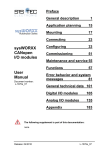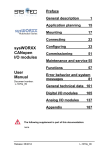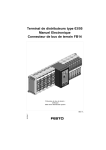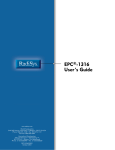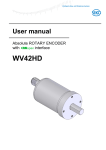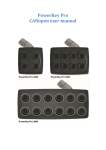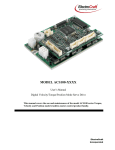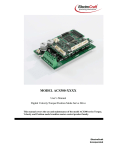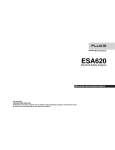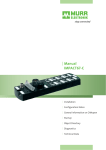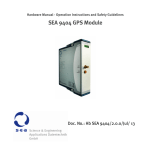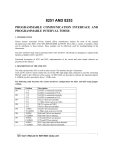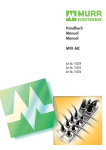Download Manual µCAN.4.ao-BOX
Transcript
Systemhaus fr Automatisierung µCAN.4.ao-BOX Manual analogue output module Version 1.00 Document conventions For better handling of this manual the following icons and headlines are used: This symbol marks a paragraph containing useful information about the device operation or giving hints on configuration. This symbol marks a paragraph which explains possible danger. This danger might cause a damage to the system or damage to personnel. Read these sections carefully! Keywords Important keywords appear in the border column to help the reader when browsing through this document. MicroControl GmbH & Co. KG Lindlaustraße 2c D-53842 Troisdorf Fon: +49 / 2241 / 25 65 9 - 0 Fax: +49 / 2241 / 25 65 9 - 11 http://www.microcontrol.net Contents 1. 2. Safety Regulations . . . . . . . . . . . . . . . . . . . . . . . . . . . . . 1 1.1 General Safety Regulations . . . . . . . . . . . . . . . . . 1 1.2 Safety Notice. . . . . . . . . . . . . . . . . . . . . . . . . . . . 2 Operation of µCAN.4.ao-BOX . . . . . . . . . . . . . . . . . . . . 3 2.1 3. 4. 5. 6. 7. Project Planning . . . . . . . . . . . . . . . . . . . . . . . . . . . . . . . 5 3.1 Module Layout . . . . . . . . . . . . . . . . . . . . . . . . . . 5 3.2 Operation Area . . . . . . . . . . . . . . . . . . . . . . . . . . 6 3.3 Maximum System Configuration . . . . . . . . . . . . . 7 3.4 Case Dimensions . . . . . . . . . . . . . . . . . . . . . . . . . 9 Assembly and Disassembly . . . . . . . . . . . . . . . . . . . . . . 11 4.1 Safety Regulations . . . . . . . . . . . . . . . . . . . . . . . 11 4.2 General Information . . . . . . . . . . . . . . . . . . . . . 12 4.3 Assembly. . . . . . . . . . . . . . . . . . . . . . . . . . . . . . 13 4.4 Disassembly . . . . . . . . . . . . . . . . . . . . . . . . . . . 14 Installation . . . . . . . . . . . . . . . . . . . . . . . . . . . . . . . . . . 15 5.1 Potential Basics . . . . . . . . . . . . . . . . . . . . . . . . . 15 5.2 EMC Considerations . . . . . . . . . . . . . . . . . . . . . 16 5.2.1 Grounding . . . . . . . . . . . . . . . . . . . . . . . . . . 17 5.2.2 Shielding of cables . . . . . . . . . . . . . . . . . . . . 18 5.2.3 CAN Cable . . . . . . . . . . . . . . . . . . . . . . . . . . 19 5.3 Power Supply . . . . . . . . . . . . . . . . . . . . . . . . . . 20 5.4 CAN Bus . . . . . . . . . . . . . . . . . . . . . . . . . . . . . . 21 5.5 Address Selection . . . . . . . . . . . . . . . . . . . . . . . 22 5.6 Baudrate . . . . . . . . . . . . . . . . . . . . . . . . . . . . . . 23 5.7 Termination . . . . . . . . . . . . . . . . . . . . . . . . . . . 25 Analogue Output Signals . . . . . . . . . . . . . . . . . . . . . . . 27 6.1 Function principle . . . . . . . . . . . . . . . . . . . . . . . 27 6.2 Pin Assignment . . . . . . . . . . . . . . . . . . . . . . . . . 28 Diagnosis. . . . . . . . . . . . . . . . . . . . . . . . . . . . . . . . . . . . 29 7.1 7.1.1 µCAN.4.ao-BOX Overview. . . . . . . . . . . . . . . . . . . . . . . . . . . . . . . 3 Network Status . . . . . . . . . . . . . . . . . . . . . . . . . 30 Representation of NMT state machine . . . . . 30 I Contents 7.1.2 Representation of CAN controller state . . . . . 31 7.1.3 Combined representation. . . . . . . . . . . . . . . 31 7.2 8. CANopen Protocol . . . . . . . . . . . . . . . . . . . . . . . . . . . . 33 8.1 Introduction . . . . . . . . . . . . . . . . . . . . . . . . . . . 34 8.2 Network Management . . . . . . . . . . . . . . . . . . . 35 8.3 SDO Communication . . . . . . . . . . . . . . . . . . . . 38 8.3.1 8.4 SDO Abort Protocol . . . . . . . . . . . . . . . . . . . 39 Object Dictionary . . . . . . . . . . . . . . . . . . . . . . . 40 8.4.1 Communication Profile. . . . . . . . . . . . . . . . . 41 8.4.2 Device Profile . . . . . . . . . . . . . . . . . . . . . . . . 49 8.5 Device monitoring. . . . . . . . . . . . . . . . . . . . . . . 55 8.5.1 Heartbeat protocol . . . . . . . . . . . . . . . . . . . . 56 8.5.2 Node guarding. . . . . . . . . . . . . . . . . . . . . . . 59 8.6 PDO Communication . . . . . . . . . . . . . . . . . . . . 60 8.6.1 Transmission Modes . . . . . . . . . . . . . . . . . . . 61 8.6.2 Receive-PDO . . . . . . . . . . . . . . . . . . . . . . . . 62 8.6.3 Receive-PDO Mapping . . . . . . . . . . . . . . . . . 64 8.6.4 Synchronisation Message . . . . . . . . . . . . . . . 65 8.7 9. Module Status . . . . . . . . . . . . . . . . . . . . . . . . . . 32 Emergency Message . . . . . . . . . . . . . . . . . . . . . 66 Technical Data . . . . . . . . . . . . . . . . . . . . . . . . . . . . . . . 67 Index . . . . . . . . . . . . . . . . . . . . . . . . . . . . . . . . . . . . . . . 69 II µCAN.4.ao-BOX General Safety Regulations Safety Regulations 1. Safety Regulations Please read the following chapter in any case, because it contains important information about the secure handling of electrical devices. 1.1 General Safety Regulations This paragraph gives important information about the conditions of use. It was written for personnel which is qualified and trained on electrical devices. Qualified and trained personnel are persons who fulfil at least one of the following conditions: z You know the safety regulations for automated machines and you are familiar with the machine. z You are the operator for the machine and you have been trained on operation modes. You are familiar with the operation of devices described in this manual. z You are responsible for setting into operation or service and you are trained on repairing automated machines. In addition you are trained in setting electrical devices into operation, to connect the earthing conductor and to label these devices. The devices described in this manual may only be used for the mentioned applications. Other devices used in conjunction have to meet the safety regulations and EMI requirements. To ensure a trouble free and safe operation of the device please take care of proper transport, appropriate storage, proper assembly as well as careful operation and maintenance. Please take care to observe the actual local safety regulations. If devices are used in a fixed machine without a mains switch for all phases or fuses, this equipment has to be installed. The fixed machine must be connected to safety earth. µCAN.4.ao-BOX MicroControl Version 1.00 Page 1 1 Safety Regulations 1 Safety Notice If devices are supplied by mains please take care that the selected input voltage fits to the local mains. 1.2 Safety Notice If devices are supplied by 24V DC, this voltage has to be isolated from other voltages. The cables for power supply, signal lines and sensor lines must be installed in a way that the device function is not influenced by EMI. Devices or machines for industrial automation must be constructed in a manner that an unintentional operation is impossible. By means of hardware and software safety precautions have to be taken in order to avoid undefined operation of an automated machine in case of a cable fraction. If automated machines can cause damage of material or personnel in case of a malfunction the system designer has to take care for safety precautions. Possible safety precautions might be a limit switch or locking. Seite 2 MicroControl Version 1.00 µCAN.4.ao-BOX Overview Operation of µCAN.4.ao-BOX 2. Operation of µCAN.4.ao-BOX 2.1 Overview The µCAN.4.ao-BOX is the right solution for the digital to analogue output of standard signals via CAN. Just sending the digital values over the CAN will generate a high precision analogue signal ( +/-10V or 0..20mA ) on the outputs. 2 Fig. 1: Four channel analogue output module µCAN.4.ao-BOX Use of a fieldbus for signal acquisition and signal generating has the advantage of reduced costs because expensive I/O cards for a PLC or PC can be omitted. In addition, the design of an application is more flexible and modifications are more easily to achieve. µCAN.4.ao-BOX MicroControl Version 1.00 Page 3 Operation of µCAN.4.ao-BOX Overview The development in automation towards decentralized „intelligent“ systems makes the communication between these components quite important. Modern automated systems require the possibility to integrate components from different manufacturers. The solution for this problem is a common bus system. All these requirements are fulfilled by the µCAN.4.ao-BOX module. The µCAN.4.ao-BOX runs on the standard fieldbus CAN. 2 Typical applications for the µCAN.4.ao-BOX are industrial automation, transportation, food industry and environmental technology. The µCAN.4.ao-BOX operates with the CAN protocol according to DS-301 (version 4.02). Other protocol stacks are available on request. space saving and compact The µCAN.4.ao-BOX is designed for heavy duty applications. The aluminium cast ensures protection class IP66. The compact, space saving case gives the freedom to mount the module in many places. cost-effective and service friendly The quick and easy integration of the µCAN.4.ao-BOX in your application reduces the development effort. Costs for material and personnel are reduced. The easy installation makes maintenance and replacement quite simple. Page 4 MicroControl Version 1.00 µCAN.4.ao-BOX Module Layout Project Planning 3. Project Planning The chapter Project Planning contains information which are important for the system engineer when using the µCAN.4.ao-BOX. These information include case dimensions and conditions of use. 3.1 Module Layout 3 The following figure shows the top view of the µCAN.4.ao-BOX PCB. Use the figure to identify the terminal blocks, LED’s and DIPswitches. 7 Term Off/On V1 I1 GNDV2 I2 GNDV3 I3 GNDV4 I4 6 GND V+ GND 5 CAN-L CAN-H Baud Modul ID 2 1 1: Baudrate switch 2: Module address / ID 3: Bi-color LED for module status 4: Bi-color LED for network status NS 4 MS 3 5: Terminal block for Power / CAN 6: Switch for CANbus termination 7: Bi-color LED for signal status 8: Terminal block for digital signals Fig. 2: Top view of the µCAN.4.ao-BOX PCB µCAN.4.ao-BOX MicroControl Version 1.00 Page 5 Project Planning Operation Area 3.2 Operation Area The µCAN.4.ao-BOX is a robust field module for the output of analogue standard signals such as +/-10V or 0(4)..20mA. The output configuration is done via software communication over the CANbus. The signals are output on the according terminal block with a high precision of 16bit resolution. The module has a power supply range of 12V - 60V DC. The µCAN.4.ao-BOX needs a four core cable for connection of power supply and CAN bus, in order to reduce the amount of cabling. Special CAN bus cables are available as accessories. 3 Page 6 MicroControl Version 1.00 µCAN.4.ao-BOX Maximum System Configuration Project Planning 3.3 Maximum System Configuration For an operational system at least one network manager must be connected to the bus. This network manager might be a PLC or PC equipped with a CAN card. Every µCAN.4.ao-BOX module is an active node. A CANopen network manager can access logically up to 127 CANopen slaves (refer to Fig. 3, “Maximum system configuration”). Every module gets a unique address, which is set up via a DIP switch. The CANbus bus is connected through the µCAN modules. The last module in the network must be terminated by a termination switch (refer to “Termination” on page 25). Network Manager NID 1 NID 2 NID 127 Fig. 3: Maximum system configuration µCAN.4.ao-BOX MicroControl Version 1.00 Page 7 3 Project Planning Maximum System Configuration The maximum cable length depends on the selected baudrate. The following table shows the maximum cable length recommended by the CAN in Automation (http://www.can-cia.org). These distances can be realized with the µCAN.4.ao-BOX. 3 Baudrate Cable length 1000 kBit/s 25 m 800 kBit/s 50 m 500 kBit/s 100 m 250 kBit/s 250 m 125 kBit/s 500 m 100 kBit/s 650 m 50 kBit/s 1000 m 20 kBit/s 2500 m Tabelle 1: Dependence of baudrate from cable length It is recommended by the CAN in Automation not to use the baudrate 100 kBit/s in new CANopen systems. Page 8 MicroControl Version 1.00 µCAN.4.ao-BOX Case Dimensions Project Planning 3.4 Case Dimensions The case dimensions of the module are given in the following drawing. The high protection class IP66 of the module allows an assembly at places with a harsh environment. It is possible to mount the module inside a switching cabinet as well as direct on a machine. Please check the technical data section for detailled information about maximum environment conditions. 125mm 3 80mm Systemhaus für Automatisierung CAN ON / CAN ERROR 57mm 20mm 20mm 20mm Fig. 4: Case dimensions µCAN.4.ao-BOX MicroControl Version 1.00 Page 9 Project Planning Case Dimensions 3 Page 10 MicroControl Version 1.00 µCAN.4.ao-BOX Safety Regulations Assembly and Disassembly 4. Assembly and Disassembly 4.1 Safety Regulations This paragraph gives important information about the conditions of use. It was written for personnel which is qualified and trained on electrical devices. Qualified and trained personnel are persons who fulfill at least one of the following conditions: z You know the safety regulations for automated machines and you are familiar with the machine. z You are the operator for the machine and you have been trained on operation modes. You are familiar with the operation of devices described in this manual. z You are responsible for setting into operation or service and you are trained on repairing automated machines. In addition you are trained in setting electrcal devices into operation, to connect the earthing conductor and to label these devices. Terms of Use The devices described in this manual can only be used for the mentioned applications. Other devices used in conjuction have to meet the safety regulations and EMI requirements. To ensure a trouble free and safe operation of the device please take care of proper transport, appropriate storage, proper assembly as well as careful operation and maintenance. µCAN.4.ao-BOX MicroControl Version 1.00 Page 11 4 Assembly and Disassembly General Information 4.2 General Information Assembly The µCAN module should be assembled on an at least 2 mm thick mounting plate or direct in the plant. The module is fixed with 2 screws of type M4, which are plugged into the bottom part of the case. You find an assembly template in the appendix of this manual. Power Supply The µCAN module requires a two core cable for power supply. The cable is inserted from the right side into the case, where the terminals for power supply are located. However it makes sense to use a four core cable in order to run the CAN bus over the same cable. 4 The non-fused earthed conductor is connected at the terminal outside the case (refer to Fig. 5, “Connection of earthed conductor”). The non-fused earthed conductor may not lead inside the case because of EMI. The non-fused earthed conductor may not lead inside the µCAN case and may not be connected to a terminal inside the case. Fig. 5: Connection of earthed conductor Operation of the µCAN module is only permitted with closed case. Page 12 MicroControl Version 1.00 µCAN.4.ao-BOX Assembly Assembly and Disassembly 4.3 Assembly Assembly is performed with help of the template attached to this manual. With the template all necessary bore-holes for screws of type M4 can easily be drilled. If the module is directly fixed to the machine make sure to take the proper drill size for tapping. 4 Fig. 6: Assembly pattern for the module When assembling several modules at the same location please make sure to leave some area for the PG screws. For a quick identification of the modules during operation you may use an adhesive label / tag on top of the module. Please write down the node ID that is set for the module. Please make sure that the first node and the last node in the CAN network are terminated with a resistor (refer to “Termination” on page 25). µCAN.4.ao-BOX MicroControl Version 1.00 Page 13 Assembly and Disassembly Disassembly 4.4 Disassembly Please make sure to disconnect the power supply from the device first! Open the cover of the module and remove all signal lines first. Next remove the cables for CAN bus and power supply from the terminals. For a safe transport remove the PG screws and close the cover again. 4 Page 14 MicroControl Version 1.00 µCAN.4.ao-BOX Potential Basics Installation 5. Installation 5.1 Potential Basics The potential environment of a system that is realized with a µCAN.4.ao-BOX module is characterized by following features: z The CAN bus potential is isolated from the power supply. z The electronic of the µCAN.4.ao-BOX module is not isolated from the power supply. z All /O signal lines are not isolated among each other. z All I/O signals are optically isolated from the CAN bus potential. 5 µCAN.4.ao-BOX MicroControl Version 1.00 Page 15 Installation EMC Considerations 5.2 EMC Considerations EMC (Electromagnetic Compatibility) is the ability of a device to work in a given electromagnetic environment without influencing this environment in a not admissible way. All µCAN modules fit these requirements and are tested for electromagnetic compatibility in a EMC laboratory. However a EMC plan should be done for the system in order to exclude potential noise sources. Noise signals can couple in different ways. Depending on that way (guided wave propagation or non-guided wave propagation) and the distance to the noise source the kinds of coupling are differentiated. DC Coupling 5 If two electronic circuits use the same conductor we speak of a DC coupling. Noise sources are in that case: starting motors, frequency converters (switching devices in general) and different potentials of cases or of the common power supply. Inductance Coupling An inductance coupling is given between two current-carrying conductors. The current in a conductor will cause a magnetic field which induces a voltage in the second conductor (transformer principle). Typical noise sources are transformer, power cables and RF signal cables. Capacitive Coupling A capacitive coupling is given between two conductors which have a different potential (principle of a capacitor). Noise sources are in that case: parallel running conductors, static discharge and contactors. RF Coupling A RF coupling is given when electromagnetic fields hit a conductor. This conductor works like an antenna for the electromagnetic field and couples the noise into the system. Typical noise sources are spark plugs and electric motors. Also a radio set might be a noise source. To reduce the impact of noise sources please take care to follow the basic EMC rules. Page 16 MicroControl Version 1.00 µCAN.4.ao-BOX EMC Considerations Installation 5.2.1 Grounding All inactive metal plates must be grounded with low impedance. This method ensures that all elements of the system will have the same potential. Please take care that the ground potential never carries a dangerous voltage. The grounding must be connected to the safety earth. The µCAN modules are grounded by the contact which is located under one of the PG screws (see fig. 5, “Connection of earthed conductor”). Additional contacts can be mounted under the PG screws for shielding purposes on demand. The ground potential may not be connected to a terminal inside the case. 5 µCAN.4.ao-BOX MicroControl Version 1.00 Page 17 Installation EMC Considerations 5.2.2 Shielding of cables If noise is coupled to a cable shield it is grounded to safety earth via the metal cover. The cable shields have to be connected to the safety earth with low impedance. Cable type For installation of the µCAN module you should only use cable with a shield that covers at least 80% of the core. Do not use cable with a shield made from metallized foil because it can be damaged very easy and has not a good shielding. Cable connection In general the cable shield should be grounded on both ends. The cable shield should only be grounded on one end if an attenuation is necessary in the low frequency range. The cable shield can not be grounded on both ends for temperature sensors. The grounding on one end of the cable is necessary if 5 z there is no contact to the safety earth possible, z analogue signals with only a few mV or mA are transmitted (e.g. temperature sensors). The shield of the CAN bus cable may not lead inside the housing of the µCAN.4.ao-BOX. Never connect the shield to the terminals inside the device. Page 18 MicroControl Version 1.00 µCAN.4.ao-BOX EMC Considerations Installation 5.2.3 CAN Cable The CAN cable must meet the requirements of ISO11898. The cable must meet the following specifications: Parameter Value Impedance 108 - 132 Ohm (nom. 120 Ohm) Specific Resistance 70 mOhm/Meter Specific Signal Delay 5 ns/Meter Tabelle 2: Specifications of CAN bus cable The CAN bus cable is connected to the µCAN.4.ao-BOX module via terminals inside the case. For the pinning of the terminals refer to “CAN Bus” on page 21 of this manual. Do not confuse the signal lines of the CAN bus, otherwise communication between the modules is impossible. µCAN.4.ao-BOX MicroControl Version 1.00 Page 19 5 Installation Power Supply 5.3 Power Supply The µCAN.4.ao-BOX module is designed for industrial applications. By means of a DC/DC converter the CAN bus of the module is isolated from the supply voltage. Also the analogoue outputs are isolated against the power supply. The supply voltage must be within the range from 12 V DC to 60 V DC. The input is protected against confusing the poles. Please make sure not to confuse the poles when connecting the power supply. The positive supply is connected to the terminal V+. There are 2 terminals for the possitive supply, which are internally connected. The negative supply is connected to the terminal GND. There are 2 terminals for the negative supply, which are internally connected. 5 Term Off/On V1 I1 GNDV2 I2 GNDV3 I3 GNDV4 I4 GND V+ GND CAN-L CAN-H Baud NS Modul ID MS GND supply V+ supply Abb. 7: Connection of power supply The maximum supply voltage for the electronic is 60V DC. Higher voltages will destroy the electronic. Page 20 MicroControl Version 1.00 µCAN.4.ao-BOX CAN Bus Installation 5.4 CAN Bus The two wires of the CAN bus are connected to the corresponding terminals. To reduce the influence of EMI please take care that the CAN bus cable does not cross the wires of the signal lines. The CAN bus line with positive potential must be connected to the terminal CAN_H. The CAN bus line with negative potential must be connected to the terminal CAN_L. Term Off/On V1 I1 GNDV2 I2 GNDV3 I3 GNDV4 I4 GND V+ 5 GND CAN-L CAN-L CAN-H Baud Modul ID CAN-H NS MS Abb. 8: Connection of CAN bus Confusing the poles of the CAN bus lines will lead to a communication error on the complete network. The shield of the CAN bus cable may not lead into the housing and may not be connected to a terminal inside the housing. Cable shields have to be connected to the terminals outside the housing. If you use a Sub-D connector with 9 pins (according to CiA standard), the conductor CAN_H is connected to pin 7 and the conductor CAN_L is connected to pin 2. µCAN.4.ao-BOX MicroControl Version 1.00 Page 21 Installation Address Selection 5.5 Address Selection Address selection of the µCAN.4.ao-BOX module is done via an 8-pin DIP-switch, marked "Modul-ID" which is located at the lower left corner of the PCB. Selection of the address may be done with a small screw driver. Modul ID 1 2 3 4 5 6 7 8 OFF Abb. 9: Setup of module address (here address 9 is shown) The 8-pin DIP-switch sets the binary code for the module address. The first pin of the switch (marked with ’1’) represents bit 0 of a byte. The last pin of the switch (marked with ’8’) represents bit 7 of a byte. 5 Valid module addresses are within the range from 1..127, resp. 01h..7Fh. Each node within a CANopen network must have a unique module address (node ID). Two nodes with the same node ID are not allowed. The selected address is read during initialization of the module, after Power-on or Reset. The module runs with the selected node ID until a new node ID is selected and a Reset is performed (via the CAN bus) or the power supply is switched off Switch 8 must always be in OFF position. Do not put all switches in the OFF position. In these configurations the module will not start to communicate on the bus. Page 22 MicroControl Version 1.00 µCAN.4.ao-BOX Baudrate Installation 5.6 Baudrate Baudrate selection of the µCAN.4.ao-BOX module is done via a 4-pin DIP-switch, marked "Baud" which is located at the lower left corner of the PCB. Selection of the baudrate may be done with a small screw driver. Baud 1 2 3 4 OFF Abb. 10: Setup of baudrate (drawing shows 1 MBit/s) The 4-pin DIP-switch sets the binary code for the module baudrate. The first pin of the switch (marked with ’1’) represents bit 0 of a byte. The last pin of the switch (marked with ’4’) represents bit 3 of a byte. The supported baudrates of the µCAN.4.ao-BOX module are given in the following table. The values are recommended by the CiA. Baudrate DIP-switch position 1 2 3 4 Autobaud / LSSa 0 0 0 0 Autobaud 1 0 0 0 20 kBit/s 0 1 0 0 50 kBit/s 1 1 0 0 100 kBit/s 0 0 1 0 125 kBit/s 1 0 1 0 250 Kbit/s 0 1 1 0 500 kBit/s 1 1 1 0 800 kBit/s 0 0 0 1 1 MBit/s 1 0 0 1 Tabelle 3: Einstellung der Baudrate a.LSS will be used only if all Adress-Switches are in the "OFF"Position and the Baudrate-Switches are in the "OFF"-Position µCAN.4.ao-BOX MicroControl Version 1.00 Page 23 5 Installation Baudrate The baudrate 10 kBit/s is not supported with the µCAN.4.aoBOX module. In the position Autobaud an automatic detection of the baudrate on the CAN bus is started. 5 Page 24 MicroControl Version 1.00 µCAN.4.ao-BOX Termination Installation 5.7 Termination The modules at both ends in the CAN network have to be terminated with a resistor of 120 ohms. That means the modules at the end of the bus line are not reflecting back power and the communication can not be disturbed. For termination of the µCAN.4.ao-BOX the "Term" switch must be turned from position "Term Off“ to position "Term On“. Please make sure that only the devices at both ends of a CAN bus are terminated. In un-powered condition the correct termination value is 60 Ohm between the lines CAN-H and CAN-L. Termination off Term Off/On V1 I1 GNDV2 I2 GNDV3 I3 GNDV4 I4 5 GND V+ GND CAN-L CAN-H Baud Modul ID NS MS Abb. 11: Termination of CAN bus Figure 10 shows the termination of the module in "off" position which is the factory default. µCAN.4.ao-BOX MicroControl Version 1.00 Page 25 Installation Termination 5 Page 26 MicroControl Version 1.00 µCAN.4.ao-BOX Function principle Analogue Output Signals 6. Analogue Output Signals The µCAN.4.ao-BOX has four analogue output signals. The terminals are labeled with "V1 I1 GND" to "V4 I4 GND" from left to right on the PCB. Please keep the basics of EMI rules in mind when planning the wiring. Only proper wiring and EMI precautions make sure that the module runs without trouble. 6.1 Function principle Configuration of each terminal (voltage or current output) is done via configuration over the CANbus. Voltage 16 Bit D/A 6 Current Abb. 12: Schematic of the analogue output terminal The internal driver architecture consist of an 16-bit digital to analogue converter. By means of additional OPVs the signals are then transformed into the voltage or current output signals. Parameter Value Driver Impedance Vout -10 .. +10 V min. 500 Ohm Iout 0 .. 20 mA max. 500 Ohm Tabelle 4: Electrical Parameters µCAN.4.ao-BOX MicroControl Version 1.00 Page 27 Analogue Output Signals Pin Assignment 6.2 Pin Assignment The terminal block of the µCAN.4.ao-BOX is designed to connect 4 analogue output signal lines. The terminal blocks marked with "V1" to "V4" will source an output voltage ( -10V .. +10V ) and the terminal blocks marked with "I1" to "I4" will source an output current ( 0 .. 20mA ). Each output has a common ground signal which can be connected to the "GND" terminal block. Term Off/On V1 I1 GNDV2 I2 GNDV3 I3 GNDV4 I4 GND V+ GND CAN-L CAN-H Baud 6 Modul ID NS MS Abb. 13: Terminals for signal lines Pin Function V1 Output 1: voltage I1 Output 1: current GND Common GND of output 1 .... .... V4 Output 4: voltage I4 Output 4: current GND Common GND of output 4 Tabelle 5: Pin assignment Make sure to connect signal lines only in powered off state in order to prevent a damage of the electronic. Page 28 MicroControl Version 1.00 µCAN.4.ao-BOX Diagnosis 7. Diagnosis All modules of the µCAN family have LEDs to display the operating state and to signalize an error state. The µCAN.4.ao-BOX has two bi-color LEDs (green/red) labeled with "NS" (Network Status) and "MS" (Module Status) on the PCB. On the case cover the LEDs are marked as ON/CAN for the network status and ERROR for the module status. 7 Term Off/On V1 I1 GNDV2 I2 GNDV3 I3 GNDV4 I4 6 GND V+ GND 5 CAN-L 7 CAN-H Baud 1 Modul ID 2 NS 4 MS 3 Abb. 14: Position of LEDs on the module In normal operation all LEDs should have a green or orange color. A red steady light or a red blinking of a LED indicates an error condition. µCAN.4.ao-BOX MicroControl Version 1.00 Page 29 Diagnosis Network Status 7.1 Network Status The bi-color LED labeled with "NS" (on the case cover marked as ON/CAN) shows the status of the CANopen state machine as well as the error state of the CAN controller. 7.1.1 Representation of NMT state machine The green light of the NS-LED represents the status of the CANopen network management state machine. Initialisation (Autobaud detection) NMT state: device is "stopped" NMT state: device is "pre-operational" 7 NMT statue: device is "operational" Page 30 MicroControl Version 1.00 µCAN.4.ao-BOX Network Status Diagnosis 7.1.2 Representation of CAN controller state The red light of the NS-LED represents the error state of the CAN controller. The red light is off during error-free condition. CAN status: controller in "warning" state CAN status: controller in "error passive" state CAN status: controller in "bus-off" state 7.1.3 Combined representation The combination of the green light and the red light of the NSLED allows the representation of both - the NMT status and the CAN controller status. The following pictures give an example of combined representation. Device in "pre-operational" state, CAN controller in "warning" state Device in "operational" state, controller in "error passive" state µCAN.4.ao-BOX MicroControl Version 1.00 Page 31 7 Diagnosis Module Status 7.2 Module Status The bi-color LED labeled with "MS" (on the case cover marked as ERROR) shows the status of the device hardware. Module status: function/power OK Module status: wrong baudrate setup Module status: wrong address setup 7 Page 32 MicroControl Version 1.00 µCAN.4.ao-BOX CANopen Protocol 8. CANopen Protocol This chapter provides detailed information on how to connect the modules of the µCAN-series to a CANopen manager. A CANopen manager might be a PLC, a PC with a CAN interface or any other CAN device with NMT functionality. For more information about CANopen manager please refer to the supplied manuals of your CANopen master device. This documentation provides the actual implemented functions and services of the µCAN.4.ao-BOX. 8 µCAN.4.ao-BOX MicroControl Version 1.00 Page 33 CANopen Protocol Introduction 8.1 Introduction The identifiers of the µCAN.4.ao-BOX are set up according to the Pre-defined Connection Set, which is described in detail in the CANopen communication profile DS-301. The following table gives an overview of the supported services. Object COB-ID (dec.) COB-ID (hex) Network Management 0 0x000 SYNC 128 0x080 EMERGENCY 129 - 255 0x081 - 0x0FF PDO 1 (Receive) 513 - 639 0x201 - 0x27F PDO 2 (Receive) 769 - 895 0x301 - 0x37F SDO (Transmit) 1409 - 1535 0x581 - 0x5FF SDO (Receive) 1537 - 1663 0x601 - 0x67F Heartbeat / Boot-up 1793 - 1919 0x701 - 0x77F Table 6: Identifier values according to the Pre-defined Connection Set The direction (Transmit / Receive) has to be seen from the devices point of view. 8 Page 34 MicroControl Version 1.00 µCAN.4.ao-BOX Network Management CANopen Protocol 8.2 Network Management By means of the Network Management (NMT) messages the state of a CANopen node can be changed (Stopped / Pre-Operational / Operational). Start Node Start Node ID DLC B0 B1 0 2 01h Nod e Node = module address, 0 = all modules By transmitting the "Start Node" command the CAN-node will be set into Operational mode. This means that the node can handle PDO-communication. Stop Node Stop Node ID DLC B0 B1 0 2 02h Nod e Node = module address, 0 = all modules By transmitting the "Stop Node" command the CAN-node will be set into Stopped mode. This means that the node can not handle any services except NMT commands. Pre-Operational Enter Pre-Operational ID DLC B0 B1 0 2 80h Nod e Node = module address, 0 = all modules By transmitting the „Enter Pre-Operational“ command the CANnode will be set into Pre-Operational mode. In this state the node can not handle PDO messages. µCAN.4.ao-BOX MicroControl Version 1.00 Page 35 8 CANopen Protocol Network Management 8 Page 36 MicroControl Version 1.00 µCAN.4.ao-BOX Network Management Reset Node CANopen Protocol Reset Node ID DLC B0 B1 0 2 81h Nod e Node = module address, 0 = all modules By transmitting the „Reset Node“ command the CAN-node will issue a reset operation. After reset the node will send a "Boot-up message" (refer to “Heartbeat protocol” on page 56) and enter the Pre-operational state automatically. 8 µCAN.4.ao-BOX MicroControl Version 1.00 Page 37 CANopen Protocol SDO Communication 8.3 SDO Communication All parameters of the devices (organized in an object dictionary) are accessed via the SDO service (Service Data Object). A SDO message has the following contents: ID DLC B0 8 CMD B1 B2 Index B3 B4 SubIndex B5 B6 B7 Data For calculation of the SDO message identifier please refer to “Introduction” on page 34. The "Command Byte" (CMD) is defined according to the following table. SDO client (CANopen ster) 8 SDO server (CANopen slave) Function 22h 60h write, size not specified 23h 60h write, size = 4 bytes 27h 60h write, size = 3 bytes 2Bh 60h write, size = 2 bytes 2Fh 60h write, size = 1 byte 40h 42h read, size not specified 40h 43h read, size = 4 bytes 40h 47h read, size = 3 bytes 40h 4Bh read, size = 2 bytes 40h 4Fh read, size = 1 byte ma- Table 7: Command byte for für SDO Expedited Botschaft The byte order for the fields "Index" and "Data" is least significant byte first (Intel format). The minimum time delay between two succeeding SDO messages must be greater than 20ms. Faster communication might lead to an unpredictible device status. Page 38 MicroControl Version 1.00 µCAN.4.ao-BOX SDO Communication CANopen Protocol 8.3.1 SDO Abort Protocol The SDO abort protocol is used to signalize a fault when accessing an object. This SDO abort protocol has the following format: ID DLC B0 B1 8 80h B2 Index B3 B4 SubIndex B5 B6 B7 Abort Code The identifier as well as the index and sub-index correspond to the SDO request. The abort code may have the following values: Abort code Description 0504 0001h Client / Server command specifier not valid / unknown 0601 0000h Unsupported access to an object 0601 0001h Attempt to read a "write-only" object 0601 0002h Attempt to write a "read-only" object 0602 0000h Object does not exist in the object dictionary 0609 0011h Sub-index does not exist Table 8: SDO abort codes 8 µCAN.4.ao-BOX MicroControl Version 1.00 Page 39 CANopen Protocol Object Dictionary 8.4 Object Dictionary This chapter describes the implemented objects for the module µCAN.4.ao-BOX. For additional information please refer to the CANopen communication profile DS-301 and the device profile DS-404. EDS The implemented objects of the module µCAN.4.ao-BOX are listed in an "Electronic Data Sheet" (EDS). The EDS file can be downloaded from the MicroControl homepage. 8 Page 40 MicroControl Version 1.00 µCAN.4.ao-BOX Object Dictionary CANopen Protocol 8.4.1 Communication Profile The module µCAN.4.ao-BOX supports the following objects from the communication profile DS-301: Index Name 1000h Device Profile 1001h Error Register 1002h Manufacturer Status 1003h Predefined Error-Register 1005h COB-ID SYNC-Message 1008h Manufacturer Device Name 1009h Manufacturer Hardware Version 100Ah Manufacturer Software Version 100Ch Guard Time 100Dh Life Time Factor 1010h Store Parameters 1011h Restore Default Parameters 1014h COB-ID Emergency-Message 1016h Heartbeat Consumer Time 1017h Heartbeat Producer Time 1018h Identity Object 1029h Error Behaviour 1400h 1st Receive PDO Parameters 1600h 1st Receive PDO Mapping Parameters 1F80h NMT Startup 8 Table 9: Supported objects of the CANopen communication profile µCAN.4.ao-BOX MicroControl Version 1.00 Page 41 CANopen Protocol Object Dictionary Device Profile Index 1000h The object at index 1000h describes the type of device and its functionality. Sub-Index Data Type Acc. Name Default Value 0 Unsigned32 ro Device Profile 0008 0194h The object is read-only. Only sub-index 0 is supported. An access to other sub-indices will lead to an error message. Example: read parameter, module ID = 2, index = 1000h ID DLC B0 B1 B2 B3 B4 B5 B6 B7 602h 8 40h 00h 10h 00h 00h 00h 00h 00h As response the µCAN.4.ao-BOX will send: ID DLC B0 B1 B2 B3 B4 B5 B6 B7 582h 8 42 00 10h 00 91h 04h 08h 00 Byte 5 + Byte 6 Byte 7 + Byte 8 = 0194h = 404d (Device Profile Number) = 0008h = 8 (Additional Information) Error Register Index 1001h 8 The object at index 1001h is an error register for the device. Sub-Index Data Type Acc. Name Default Value 0 Unsigned8 ro Error Register 00h The object is read-only. Only sub-index 0 is supported. An access to other sub-indices will lead to an error message. Example: read parameter, module ID = 2, Index = 1001h Page 42 ID DLC B0 B1 B2 B3 B4 B5 B6 B7 602h 8 40h 01h 10h 00 00 00 00 00 MicroControl Version 1.00 µCAN.4.ao-BOX Object Dictionary CANopen Protocol As response the module will return its error register value. The following error types are supported: Generic Error Bit 0 is set to ’1’. The generic error is set due to hardware faults. Communication Error Bit 4 is set to ’1’. The communication error is set due to faults on the CAN bus. The object is read-only. Only sub-index 0 is supported. An access to other sub-indices will lead to an error message. Pre-defined Error Field Index 1003 The object at index 1003h holds the errors that have occured on the device. The object stores a maximum of 10 error conditions. Sub-Index Data Type Acc. Name Default Value 0 Unsigned8 rw Number of errors 00h 1 .. 10 Unsigned32 ro Standard error field 0000 0000h The object supports the sub-indices 0 to 10. An access to other sub-indices will lead to an error message. Writing to sub-index 0 will clear the error history. Example: read parameter, module ID = 2, Index = 1003h ID DLC B0 B1 B2 B3 B4 B5 B6 B7 602h 8 40h 03h 10h 05h 00h 00h 00h 00h As response the module will return the error value at position 5 in the history. µCAN.4.ao-BOX MicroControl Version 1.00 Page 43 8 CANopen Protocol Object Dictionary Manufacturer Device Name Index 1008 The object at index 1008h contains the manufacturer device name. Sub-Index Data Type Acc. Name Default Value 0 Visible String ro Device name mCAN.4.ao-BOX The object is read-only. Only sub-index 0 is supported. An access to other sub-indices will lead to an error message. Manufacturer Hardware Version Index 1009h The object at index 1009h contains the manufacturer hardware version. Sub-Index Data Type Acc. Name Default Value 0 Visible String ro Hardware version - The object is read-only. Only sub-index 0 is supported. An access to other sub-indices will lead to an error message. Manufaturer Software Version Index 100Ah 8 The object at index 100Ah contains the manufacturer software version. Sub-Index Data Type Acc. Name Default Value 0 Visible String ro Software version - The object is read-only. Only sub-index 0 is supported. An access to other sub-indices will lead to an error message. Page 44 MicroControl Version 1.00 µCAN.4.ao-BOX Object Dictionary CANopen Protocol Store Parameters Index 1010h The object at index 1010h supports the saving of parameters in a non volatile memory. Sub-Index Data Type Acc. Name Default Value 0 Unsigned8 ro Number of objects 04h 1 Unsigned32 rw Save all parameters 0000 0001h 2 Unsigned32 rw Save communication 0000 0001h 3 Unsigned32 rw Save application 0000 0001h 4 Unsigned32 rw Save manufacturer 0000 0001h In order to avoid storage of parameters by mistake, storage is only executed when a specific signature is written to the appropriate sub-index. The signature is "save". Example: save all parameters, module ID = 2, index = 1010h ID DLC B0 B1 B2 B3 B4 B5 B6 B7 602h 8 23h 10h 10h 01h 73h 61h 76h 65h As response the µCAN.4.ao-BOX will send: ID DLC B0 B1 B2 B3 B4 B5 B6 B7 582h 8 60h 10h 10h 01h 00h 00h 00h 00h Parameters are stored in a non-volatile memory after reception of the store request message. µCAN.4.ao-BOX MicroControl Version 1.00 Page 45 8 CANopen Protocol Object Dictionary Restore Default Parameters Index 1011h The object at index 1011h supports the restore operation of default parameters. Sub-Index Data Type Acc. Name Default Value 0 Unsigned8 ro Number of objects 04h 1 Unsigned32 rw Restore all param. 0000 0001h 2 Unsigned32 rw Restore commun. 0000 0001h 3 Unsigned32 rw Restore application 0000 0001h 4 Unsigned32 rw Restore manufacturer 0000 0001h In order to avoid the restoring of default parameters by mistake, restoring is only executed when a specific signature is written to the appropriate sub-index. The signature is "load". Example: restore all parameters, module ID = 2, Index = 1011h ID DLC B0 B1 B2 B3 B4 B5 B6 B7 602h 8 23h 11h 10h 01h 6Ch 6Fh 61h 64h As response the µCAN.4.ao-BOX will send: ID DLC B0 B1 B2 B3 B4 B5 B6 B7 582h 8 60h 11h 10h 01h 00h 00h 00h 00h 8 COB-ID for emergency message Index 1014h The object at index 1014h defines the identifier value for the emergency message. Sub-Index Data Type Acc. Name Default Value 0 Unsigned32 rw COB-ID EMCY 80h + NodeID Only sub-index 0 is supported. An access to other sub-indices will lead to an error message. The default value for the identifier is 80h + selected node ID. Page 46 MicroControl Version 1.00 µCAN.4.ao-BOX Object Dictionary CANopen Protocol Identity Object Index 1018h The object at index 1018h holds the identity object (LSS address) of device. Sub-Index Data Type Acc. Name Default Value 0 Unsigned8 ro Largest Sub-Index 4 1 Unsigned32 ro Vendor ID 0000 000Eh 2 Unsigned32 ro Product Code 0013 A745h 3 Unsigned32 ro Revision Number 0298 00xxh 4 Unsigned32 ro Serial Number - The object is read-only. Only sub-indices 0 to 4 are supported. An access to other sub-indices will lead to an error message. Vendor ID The "Vendor ID" contains a unique value allocated to each manufacturer. The numbers are managed by the CAN in Automation Product Code The "Product Code" identifies a specific product, i.e. it is unique to the order code of devices from MicroControl. Revision Number The "Revision Number" consists of a major revision number (upper word) and a minor revision number (lower word). The major revision number identifies a specific CANopen behaviour. The minor revision number identifies different versions with the same CANopen behaviour. Serial Number The "Serial Number" contains the serial number of a device. 8 µCAN.4.ao-BOX MicroControl Version 1.00 Page 47 CANopen Protocol Object Dictionary Error behaviour Index 1029h If a serious CANopen device failure is detected in NMT state Operational, the CANopen device will enter by default autonomously the NMT state Pre-operational. The object 1029h allows the device to enter alternatively the NMT state Stopped or remain in the current NMT state. Sub-Index Data Type Acc. Name Defaul Value 0 Unsigned8 ro number of entries 01h 1 Unsigned8 rw Communication error 00h The following codes are possible: Value Description 00h Change to NMT state Pre-operational 01h No change of the NMT state 02h Change to NMT state Stopped Table 10: Codes for error behaviour setup The device detects the following communication errors: z Bus-off conditions of the CAN interface z Life guarding event with the state "occurred" and the reason "time out" z Heartbeat event with state "occurred" and the reason "time out" 8 Page 48 MicroControl Version 1.00 µCAN.4.ao-BOX Object Dictionary CANopen Protocol 8.4.2 Device Profile This section describes all device profile specific objects (DS-404) of the µCAN.4.ao-BOX: Index Name 6301h AO Physical Unit 6302h AO Decimal Digits 6310h AO Output Type 6340h AO Fault Mode 7300h Output Process Value 7330h Output Field Value 7341h Output Fault Value Table 11: Supported objects of the device profile DS-404 8 µCAN.4.ao-BOX MicroControl Version 1.00 Page 49 CANopen Protocol Object Dictionary AO Physical Unit Index 6301h The object at index 6301h defines the physical unit of the process value. Sub-Index Data Type Acc. Name Default Value 0 Unsigned8 ro Largest Sub-Index 04h 1 Unsigned16 ro Physical Unit Out 1 000Bh 2 Unsigned16 ro Physical Unit Out 2 000Bh 3 Unsigned16 ro Physical Unit Out 3 000Bh 4 Unsigned16 ro Physical Unit Out 4 000Bh The object allows read-only access. Only sub-indices 0 to 4 are supported. An access to other sub-indices will lead to an error message. The following signal types are supported. Each channel can be configured individually. Value Function 0Bh Volt 15h mA Table 12: Output signal type definitions AO Decimal Digits 8 Index 6302h The object at index 6302h defines the number of digits after the comma (fixed-point representation). Sub-Index Data Type Acc. Name Default Value 0 Unsigned8 ro Largest Sub-Index 04h 1 Unsigned8 ro Decimal Digits Out 1 03h 2 Unsigned8 ro Decimal Digits Out 2 03h 3 Unsigned8 ro Decimal Digits Out 3 03h 4 Unsigned8 ro Decimal Digits Out 3 03h The object allows read-only access. Only sub-indices 0 to 4 are supported. An access to other sub-indices will lead to an error message. The number of decimal digits after the comma is always 3, i.e. the process value has a resolution of 0,001 V or mA. Page 50 MicroControl Version 1.00 µCAN.4.ao-BOX Object Dictionary CANopen Protocol Analogue Output Signal Type Index 6310h The object at index 6310h defines the analogue output signal type. Sub-Index Data Type Acc. Name Default Value 0 Unsigned8 ro Largest Sub-Index 04h 1 Unsigned16 rw Signal Type Output 1 000Bh 2 Unsigned16 rw Signal Type Output 2 000Bh 3 Unsigned16 rw Signal Type Output 3 000Bh 4 Unsigned16 rw Signal Type Output 4 000Bh The object allows read write access. Only sub-indices 0 to 4 are supported. An access to other sub-indices will lead to an error message. The following signal types are supported. Each channel can be configured individually. Value Function 0Bh Voltage Output ( +/- 10 V ) 15h Current Output ( 0..20 mA ) Table 13: Output signal type definitions Example: Set output type to current, module address 1, channel 1 8 ID DLC B0 B1 B2 B3 B4 B5 B6 B7 601h 8 22h 10h 63h 01h 15h 00h 00h 00h As response the µCAN.4.ao-BOX will send: µCAN.4.ao-BOX ID DLC B0 B1 B2 B3 B4 B5 B6 B7 581h 8 60h 10h 63h 01h 00h 00h 00h 00h MicroControl Version 1.00 Page 51 CANopen Protocol Object Dictionary Analogue Output Fault Mode Index 6340h The object at index 6340h defines the analogue output signal in case of an error. The signal can be defined in the AO Output Faulr Value Object ( 7341h ). An error can be a Heart-Beat Timeout, Node-Guard Event or Bus-Off situation. Sub-Index Data Type Acc. Name Default Value 0 Unsigned8 ro Largest Sub-Index 04h 1 Unsigned8 rw Signal Type Output 1 00 2 Unsigned8 rw Signal Type Output 2 00 3 Unsigned8 rw Signal Type Output 3 00 4 Unsigned8 rw Signal Type Output 4 00 The object allows read write access. Only sub-indices 0 to 4 are supported. An access to other sub-indices will lead to an error message. The following fault types are supported. Each channel can be configured individually. Value Function 00h Actual output remains unchanged 01h Output will be changed to value according to settings in Object 7341h / Output Fault Value Table 14: Output signal type definitions 8 Page 52 MicroControl Version 1.00 µCAN.4.ao-BOX Object Dictionary CANopen Protocol AO Process Value Index 7300h The object at index 7300h holds the 16-bit values to set up the according output individually. Sub-Index Data Type Acc. Name Default Value 0 Unsigned8 ro Largest Sub-Index 04h 1 Unsigned16 rw Output 1 0000 2 Unsigned16 rw Output 2 0000 3 Unsigned16 rw Output 3 0000 4 Unsigned16 rw Output 4 0000 The object allows read write access. Only sub-indices 0 to 4 are supported. An access to other sub-indices will lead to an error message. In the following tables there are shown some output values for the object 7300h and the according sinals which can be seen on the terminal block output. Example values for the AO signal type "Voltage" Object 7300h, Sub x Output Signal 00 00h 0,000 V 03 E8h 1,000 V EC 78h -5,000 V 27 10h 10,000V 8 Table 15: Output signal examples / Voltage Example values for the AO signal type "Current" Object 7300h, Sub x Output Signal 00 00h 0,000 mA 03 E8h 1,000 mA 27 10h 10,000 mA 4E 20h 20,000 mA Table 16: Output signal examples / Voltage µCAN.4.ao-BOX MicroControl Version 1.00 Page 53 CANopen Protocol Object Dictionary AO Field Value Index 7330h The object at index 7330h holds the raw digital values of the DACs for each input. Sub-Index Data Type Acc. Name Default Value 0 Unsigned8 ro Largest Sub-Index 04h 1 Unsigned32 ro DAC Value 1 - 2 Unsigned32 ro DAC Value 2 - 3 Unsigned32 ro DAC Value 3 - 4 Unsigned32 ro DAC Value 4 - The object allows read-only access. Only sub-indices 0 to 4 are supported. An access to other sub-indices will lead to an error message. Here the digital values for the DAC output can be read for each channel. The digital values might not be always linear to the output signal due to some internal scaling / calibration parameters. AO Output Fault Value Index 7341h 8 The object at index 7341h holds the 16-bit values to be written to the analogue output in case of an error condition. Each output channel can be set up individually. Sub-Index Data Type Acc. Name Default Value 0 Unsigned8 ro Largest Sub-Index 04h 1 Unsigned16 rw Output 1 0000 2 Unsigned16 rw Output 2 0000 3 Unsigned16 rw Output 3 0000 4 Unsigned16 rw Output 4 0000 The object allows read write access. Only sub-indices 0 to 4 are supported. An access to other sub-indices will lead to an error message. The values can be written in the ranges according to object 7300. The output value will only be set in case of an error if the object 6340h ( AO Fault Mode ) is set up properly. Page 54 MicroControl Version 1.00 µCAN.4.ao-BOX Device monitoring CANopen Protocol 8.5 Device monitoring For device monitoring CANopen provides two mechanisms (protocols): z heartbeat z node guarding It is recommended by the CAN in Automation not to use node guarding for device monitoring (CiA AN802 V1.0: CANopen statement on the use of RTR messages). 8 µCAN.4.ao-BOX MicroControl Version 1.00 Page 55 CANopen Protocol Device monitoring 8.5.1 Heartbeat protocol The heartbeat protocol is used in order to survey other CANopen nodes in the network and retrieve their network state. heartbeat ID The identifier for the heartbeat protocol is set to 700h + module address. The identifier can not be changed. The message repetition time (called "heartbeat producer time") is configured with object 1017h. The heartbeat protocol transmits one byte of data, which represents the network state. Network State Code (dec.) Code (hex) Bootup 0 00h Stopped 4 04h Operational 5 05h Pre-Operational 127 7Fh Table 17: Status Information for Heartbeat After Power-on / Reset the module will send the "Boot-up message" to signal that it finished the initialization sequence. Example: Power-on of module with address 2 8 Page 56 ID DLC B0 702h 1 00h MicroControl Version 1.00 µCAN.4.ao-BOX Device monitoring CANopen Protocol Consumer heartbeat time Index 1016h The object at index 1016h defines the consumer heartbeat time. Sub-Index Data Type Acc. Name Default Value 0 Unsigned8 ro Number of objects 2 1 Unsigned32 rw Heartbeat Cons. 1 0000 0000h 2 Unsigned32 rw Heartbeat Cons. 2 0000 0000h The µCAN.4.ao-BOX can monitor the presence of two other devices (heartbeat producer) in the network. If a heartbeat producer message is not received within an adjustable period, an emergency message with value 8130h (life guard error or heartbeat error) is transmitted. The 32-bit value of the object defines heartbeat time and the producers node address. Bit 31 ... 24 Bit 23 ... 16 Bit 15 ... 0 reserved (00h) producer node address heartbeat producer time If the heartbeat time is 0 or the node-ID is 0 or greater than 127 the corresponding object entry is not used. The heartbeat time is given in multiples of 1 millisecond. Monitoring starts after reception of the first heartbeat. 8 µCAN.4.ao-BOX MicroControl Version 1.00 Page 57 CANopen Protocol Device monitoring Producer heartbeat time Index 1017h The object at index 1017h defines the cycle time of the heartbeat. The producer heartbeat time is 0 if it is not used. The time is a multiple of 1ms. Sub-Index Data Type Acc. Name Default Value 0 Unsigned16 rw Producer Time 0000h The object allows read-write access. Only sub-index 0 is supported. An access to other sub-indices will lead to an error message. Example: Producer time 1000 ms, module address 1 ID DLC B0 B1 B2 B3 B4 B5 B6 B7 601h 8 22h 17h 10h E8h 03h 00h 00h 00h The answer you will receive from the module is: ID DLC B0 B1 B2 B3 B4 B5 B6 B7 581h 8 60h 17h 10h 00h 00h 00h 00h 00h The heartbeat producer time is not saved inside the non-volatile memory autonomously. It is necessary to store this parameter via object 1010h (refer to “Store Parameters” on page 45). 8 Page 58 MicroControl Version 1.00 µCAN.4.ao-BOX Device monitoring CANopen Protocol 8.5.2 Node guarding The NMT master polls each NMT slave at regular time intervals. This time-interval is called the guard time. The response of the NMT slave contains the NMT state of that NMT slave. The node lifetime is given by the guard time multiplied by the lifetime factor. If the NMT slave has not been polled during its lifetime, a remote node error is indicated through the NMT service life guarding event. Upon life guard error the µCAN.4.ao-BOX will transmit an emergency message with emergency code 8130h. Guard time Index 100Ch The object at index 100Ch defines the guard time. The life time factor multiplied with the guard time gives the life time for the life guarding protocol. Sub-Index Data Type Acc Name Default Value 0 Unsigned16 rw Guard time 0000h The value is given in multiple of 1 millisecond. The value of 0000h disables the life guarding. Life time factor Index 100Dh The object at index 100Dh defines the life time factor. The life time factor multiplied with the guard time gives the life time for the life guarding protocol. Sub-Index Datentyp Zugriff Bedeutung Defaultwert 0 Unsigned8 rw Life time factor 00h The value 00h disables the life guarding. µCAN.4.ao-BOX MicroControl Version 1.00 Page 59 8 CANopen Protocol PDO Communication 8.6 PDO Communication The real-time data transfer is performed by means of "Process Data Objects" (PDO). The transfer of PDOs is performed with no protocol overhead. PDO communication is only possible when the device is in the network state "Operational". 8 Page 60 MicroControl Version 1.00 µCAN.4.ao-BOX PDO Communication CANopen Protocol 8.6.1 Transmission Modes Event Driven Message transmission is triggered by the occurrence of an object specific event. For synchronous PDOs this is the expiration of the specified transmission period, synchronised by the reception of the SYNC object. For acyclically transmitted synchronous PDOs and asynchronous PDOs the triggering of a message transmission is a device-specific event specified in the device profile. Timer Driven Message transmission is either triggered by the occurrence of a device-specific event or if a specified time has elapsed without occurrence of an event. The µCAN.4.ao-BOX does not support the RTR-based PDO transmission types FCh (252d) and FDh (253d). Bit 30 inside the COBID field of the PDO communication parameter record is always set to 1. 8 µCAN.4.ao-BOX MicroControl Version 1.00 Page 61 CANopen Protocol PDO Communication 8.6.2 Receive-PDO Index 1400h The object at index 1400h defines communication parameters for the Receive-PDO. Sub-Index Data Type Acc. Name Default Value 0 Unsigned8 ro Largest Sub-Index 2 1 Unsigned32 rw COB-ID for PDO 200h + Node 2 Unsigned8 rw Transmission Type FFh Only sub-indices 0 to 2 are supported. An access to other subindices will lead to an error message. COB-ID for PDO Sub-Index 1 defined the identifier for the Receive PDO. The 32bit value has the following structure. Bit 31 Bit 30 Bit 29 Bit 28 - 0 PDO valid, 0 = valid 1 = not valid RTR allowed, 0 = yes 1 = no RTR Frame type, 0 = 11 Bit 1 = 29 Bit Identifier, Tabelle 18: Definition of COB-ID for PDO In order to enable the PDO the most significant bit (Bit 31) must be set to 0. In order to disable the PDO the most significant bit must be set to 1. In the default setting the PDO is active (Bit 31 = 0). 8 Transmission Type The transmission type defines the transmission character of the PDO. Transmission Type Description 00h acyclic synchronous, 01h - F0h (1 - 240 dez) cyclic synchronous, Tabelle 19: Einstellung des Transmission Type The Receive-PDO processes a message with 8 byte process data. The contents is copied into object 7300h (refer to “Index 7300h” on page 53) and modifies the digital outputs. Page 62 MicroControl Version 1.00 µCAN.4.ao-BOX PDO Communication CANopen Protocol The Receive PDO has to be send with 8 Byte of data. The contents of that 8 Byte data field is copied to the object 7300, with 2 Byte each for the output channels. So by receiving the Rx-PDO the output values will change on receiving new / different data. Example: Receiving an Rx-PDO ( Default PDO-ID / Modul address = 1 ). ID DLC B0 B1 B2 B3 B4 B5 B6 B7 201h 8 00h 00h 00h 00h 00h 00h 00h 00h Sub -Index B0 B1 01h Output 1 00 00 Sub -Index B2 B3 02h Output 2 00 00 Sub -Index B4 B5 03h Output 3 00 00 Sub -Index B6 B7 04h Output 4 00 00 Index 7300h 8 Example: Set up +5V on channel 2.(Modul ID: 1) ID DLC B0 B1 B2 B3 B4 B5 B6 B7 201h 8 00h 00h 4Ch 1Dh 00h 00h 00h 00h A communication with PDOs is only possible in Operational Mode. µCAN.4.ao-BOX MicroControl Version 1.00 Page 63 CANopen Protocol PDO Communication 8.6.3 Receive-PDO Mapping Index 1600h The object at index 1600h defines the mapping parameters for the Receive-PDO Sub-Index Data Type Acc. Name Default Value 0 Unsigned8 ro Largest Sub-Index 4 1 Unsigned32 ro Process Value Out 1 73000110 2 Unsigned32 ro Process Value Out 2 73000210 3 Unsigned32 ro Process Value Out 3 73000310 4 Unsigned32 ro Process Value Out 4 73000410 The object allows read-only access. Only sub-indices 0 to 4 are supported. An access to other sub-indices will lead to an error message. 8 Page 64 MicroControl Version 1.00 µCAN.4.ao-BOX PDO Communication CANopen Protocol 8.6.4 Synchronisation Message Index 1005h The object at index 1005h defines the identifier for the SYNCmessage. On reception of a message with this identifier the receipt / processing of PDOs is triggered (refer to “Receive-PDO” on page 62).. Sub-Index Data Type Acc. Name Default Value 0 Unsigned32 rw COB-ID SYNC 80h Only sub-index 0 is supported. An access to other sub-indices will lead to an error message. Example: Set SYNC-ID to 10, module address 1 ID DLC B0 B1 B2 B3 B4 B5 B6 B7 601h 8 22h 05h 10h 0Ah 00h 00h 00h 00h As answer you will get the following message: ID DLC B0 B1 B2 B3 B4 B5 B6 B7 581h 8 60h 05h 10h 00h 00h 00h 00h 00h The default identifier is 80h in order to ensure a high priority of the SYNC-message. The SYNC-identifier is not saved inside the non-volatile memory autonomously. It is necessary to store this parameter via object 1010h (refer to “Store Parameters” on page 45) µCAN.4.ao-BOX MicroControl Version 1.00 Page 65 8 CANopen Protocol Emergency Message 8.7 Emergency Message Emergency objects are triggered by the occurrence of a device internal error situation and are transmitted from an emergency producer on the device. An emergency is different from a SDO error message. The last one only holds the access error to the object dictionary, whereas an emergency indicates a severe hardware/software failure. The emergency identifier has the default value 128d + moduleaddress. The emergency message has the following structure: ID DLC 8 B0 B1 B2 Error Code ER B3 B4 B5 B6 B7 Manufacturer Specific Error Field The following emergency error codes are supported: 8 Error Code Description 0000h Error reset or no error 1000h generic error 5000h module hardware 6000h module software 8100h CAN controller entered "warning" state 8110h CAN controller overrun 8120h CAN controller entered "error passive" state 8130h heartbeat event / node guarding event 8140h device recovered bus-off 8150h identifier collision (Tx-ID reception) Table 20: Emergency error codes Page 66 MicroControl Version 1.00 µCAN.4.ao-BOX Technical Data 9. Technical Data Power Supply Supply Voltage, UPWR 12 .. 60 V DC, reverse current protected Power Consumption 1,5 W (60 mA @ 24 V DC) without load Isolation Fieldbus/Supply: 500 Veff Isolation Analogue Output Block/Supply: 500 Veff Physical Interface Terminal Block (2,5 mm2 ) CAN-Bus Baudrates 20 kBit/s .. 1 MBit/s Status on the bus active node Protocol CANopen, DS-404 Physical Interface Terminal Block (2,5 mm2 ) EMC µCAN.4.ao-BOX Electromagnetic immunity according to EN 50082-2 Electrostatic discharge 8 kV air discharge, 4 kV contact discharge, according to EN 61000-4-2 Electromagnetic fields 10 V/m, according to ENV 50204 Burst 5 kHz, 2 kV according to EN 6100-4-4 Conducted RF-Disturbance 10 V, according to EN 61000-4-6 Electromagnetic emission according to EN 50081-2 MicroControl Version 1.00 Seite 67 9 Technical Data Mechanic Case Aluminium Dimensions 125 * 80 * 57 mm (L * B * H) Weight 540 g Protection class IP66 Analogue Outputs / Voltage Impedance min. 500 Ohm Signal Span -10V .. +10V DC Protection Short Circuit protected Resolution 16 bit Accuracy (@ 23°C) 0,02% of Span End Analogue Outputs / Current Impedance max. 500 Ohm Signal Span 0 .. 20 mA DC Protection Short Circuit protected Resolution 16 bit Accuracy (@ 23°C) 0,01% of Span End 9 Seite 68 MicroControl Version 1.00 µCAN.4.ao-BOX Index Index A Address range 22 selection 22 Autobaud 24 B Baudrate automatic detection 24 bus length 8 setup 23 Bootup message 56 C Cable length 8 CAN cable 19 connection 21 CANopen DS-301 34 DS-404 49 Case dimensions 9 Communication Profile 40 D N Network Management 35 Enter Pre-Operational 35 Reset Node 37 Start Node 35 Stop Node 35 Network manager 7 Network Status LED 29 NMT see Network Management Node Guarding 59 Non-fused earthed conductor 12 O Object 1000h 42 1001h 42 1003h 43 1005h 65 1008h 44 1009h 44 100Ah 44 1010h 45 1011h 46 1014h 46 1017h 58 1018h 47 1029h 48 1400h 62, 64 Device Profile 42 E EMC 16 EMCY see Emergency message Emergency message 66 H Heartbeat Protocol 56 Consumer 57 Producer 58 I P PDO see Process Data Object Power supply 20 Pre-defined Connection Set 34 Pre-defined Error Field 43 Process Data Object 60 Transmission modes 61 S SYNC see Synchronisation Message Synchronisation Message 65 Identity object 47 T M Manufacturer Device Name 44 Module Status LED 29 µCAN.4.ao-BOX Terminal CAN bus 21 GND 20 power supply 20 Termination 25 69 Index 70 µCAN.4.ao-BOX MicroControl reserves the right to modify this manual and/or product described herein without further notice. Nothing in this manual, nor in any of the data sheets and other supporting documentation, shall be interpreted as conveying an express or implied warranty, representation, or guarantee regarding the suitability of the products for any particular purpose. MicroControl does not assume any liability or obligation for damages, actual or otherwise of any kind arising out of the application, use of the products or manuals. The products described in this manual are not designed, intended, or authorized for use as components in systems intended to support or sustain life, or any other application in which failure of the product could create a situation where personal injury or death may occur. No part of this documentation may be copied, transmitted or stored in a retrieval system or reproduced in any way including, but not limited to, photography, magnetic, optic or other recording means, without prior written permission from MicroControl GmbH & Co. KG. © 2009 MicroControl GmbH & Co. KG, Troisdorf µCAN.4.ao-BOX MicroControl Version 1.00 Page 71 Systemhaus fr Automatisierung MicroControl GmbH & Co. KG Lindlaustraße 2c D-53842 Troisdorf Fon: +49 / 2241 / 25 65 9 - 0 Fax: +49 / 2241 / 25 65 9 - 11 http://www.microcontrol.net












































































